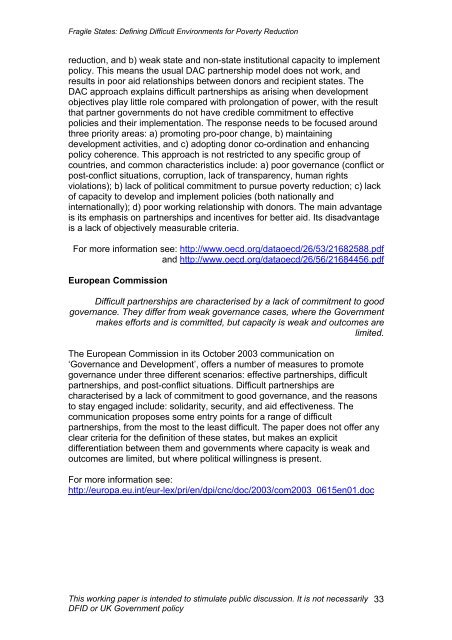Fragile States: Defining Difficult Environments for Poverty ... - INEE
Fragile States: Defining Difficult Environments for Poverty ... - INEE
Fragile States: Defining Difficult Environments for Poverty ... - INEE
Create successful ePaper yourself
Turn your PDF publications into a flip-book with our unique Google optimized e-Paper software.
<strong>Fragile</strong> <strong>States</strong>: <strong>Defining</strong> <strong>Difficult</strong> <strong>Environments</strong> <strong>for</strong> <strong>Poverty</strong> Reductionreduction, and b) weak state and non-state institutional capacity to implementpolicy. This means the usual DAC partnership model does not work, andresults in poor aid relationships between donors and recipient states. TheDAC approach explains difficult partnerships as arising when developmentobjectives play little role compared with prolongation of power, with the resultthat partner governments do not have credible commitment to effectivepolicies and their implementation. The response needs to be focused aroundthree priority areas: a) promoting pro-poor change, b) maintainingdevelopment activities, and c) adopting donor co-ordination and enhancingpolicy coherence. This approach is not restricted to any specific group ofcountries, and common characteristics include: a) poor governance (conflict orpost-conflict situations, corruption, lack of transparency, human rightsviolations); b) lack of political commitment to pursue poverty reduction; c) lackof capacity to develop and implement policies (both nationally andinternationally); d) poor working relationship with donors. The main advantageis its emphasis on partnerships and incentives <strong>for</strong> better aid. Its disadvantageis a lack of objectively measurable criteria.For more in<strong>for</strong>mation see: http://www.oecd.org/dataoecd/26/53/21682588.pdfand http://www.oecd.org/dataoecd/26/56/21684456.pdfEuropean Commission<strong>Difficult</strong> partnerships are characterised by a lack of commitment to goodgovernance. They differ from weak governance cases, where the Governmentmakes ef<strong>for</strong>ts and is committed, but capacity is weak and outcomes arelimited.The European Commission in its October 2003 communication on‘Governance and Development’, offers a number of measures to promotegovernance under three different scenarios: effective partnerships, difficultpartnerships, and post-conflict situations. <strong>Difficult</strong> partnerships arecharacterised by a lack of commitment to good governance, and the reasonsto stay engaged include: solidarity, security, and aid effectiveness. Thecommunication proposes some entry points <strong>for</strong> a range of difficultpartnerships, from the most to the least difficult. The paper does not offer anyclear criteria <strong>for</strong> the definition of these states, but makes an explicitdifferentiation between them and governments where capacity is weak andoutcomes are limited, but where political willingness is present.For more in<strong>for</strong>mation see:http://europa.eu.int/eur-lex/pri/en/dpi/cnc/doc/2003/com2003_0615en01.docThis working paper is intended to stimulate public discussion. It is not necessarilyDFID or UK Government policy33
















